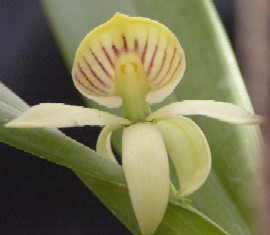

Ideal Light Ranges
For orchids to bloom, and to grow properly, they require the right amount of light. Below are TYPICAL guidelines for a number of different genera of orchids.
If you don’t have a light meter, you can use a camera to estimate the level of light your orchids are receiving.
Set your camera to ASA 25 and set the shutter speed to 1/60th of a second. Point the lens to a sheet of white paper and adjust the lens opening for proper exposure. The following table shows the level of light, measured in foot-candles in relation to the lens opening.
f-stop |
Foot-candles |
|
2.8 |
200 |
|
4 |
370 |
|
5.6 |
750 |
|
8 |
1500 |
|
11 |
2800 |
|
16 |
5000 |
Ideal Light Guidelines |
||
| Genus | Min/Max foot-candles |
|
| Brassavola | 2,000 - 4,000 |
|
| Brassia | 2,000 - 3,500 |
|
| Cattleya | 2,000 - 3,500 |
|
| Cymbidium | ||
| standard | 2,000 - 4,000 |
|
| miniature | 1,000 - 3,500 |
|
| Dendrobium | 1,000 - 4,000 |
|
| Encyclia | 2,000 - 3,500 |
|
| Epidendrum | 1,000 - 3,500 |
|
| Laelia | 2,000 - 3,500 |
|
| Ludisia | 500 - 2,000 |
|
| Masdevallia | 500 - 2,500 |
|
| Miltonia | 500 - 3,000 |
|
| Odontonglossum | 1,000 - 2,500 |
|
| Oncidium | 2,000 - 4,000 |
|
| Paphiopendilum | ||
| green leaf | 2,000 - 3,000 |
|
| mottled leaf | 2,000 - 3,000 |
|
| Phalaenopsis | 1,000 - 1,500 |
|
| Phragmipedium | 2,500 - 3,500 |
|
| Sophronitis | 1,500 - 3,000 |
|
| Vanda | 2,500 - 4,000 |
|
These guidelines are just that - GUIDELINES. Inspect the leaf color of your plants. Dark green leaves suggest not enough light. Pale green leaves suggest too much light. Move your plants or adjust the shade accordingly.